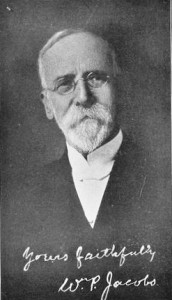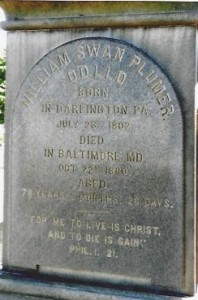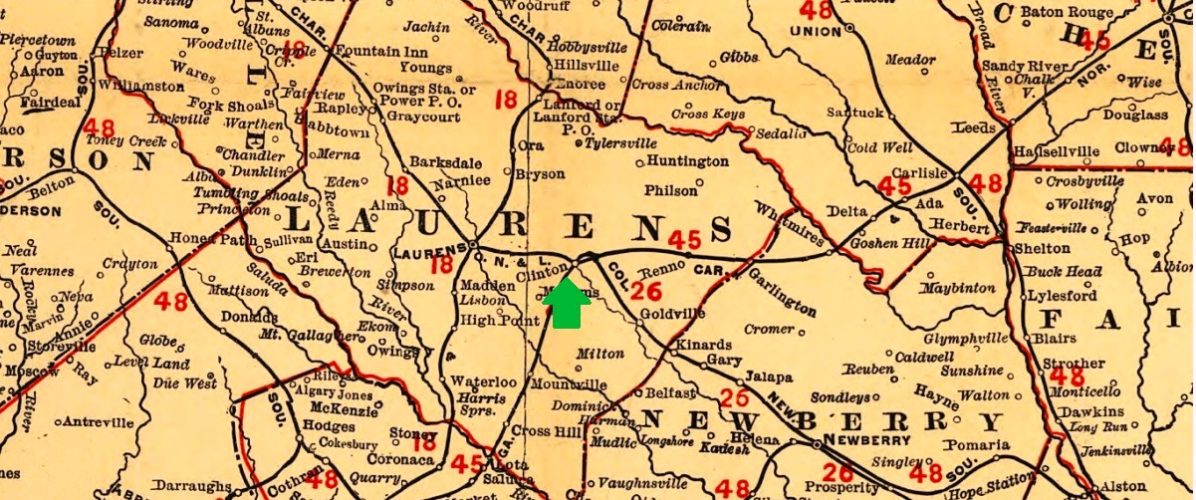 William Plumer Jacobs was born to Rev. Ferdinand and Mary Elizabeth (Redbrook) Jacobs in Yorkville (York), South Carolina, March 15, 1842. Ferdinand had been born in Alexandria, Virginia and after completing formal education at Hampden-Sydney College and Union Seminary served churches in Alabama, Georgia, and South Carolina. Ferdinand had worked as president of Laurens Female Seminary; principal of the Charleston Female Seminary; and he taught at Oglethorpe University. His ministry would provide the pattern for William as he too would become a teaching elder of varied interests and a presbyter worthy of double honor for working in several areas of ministry.
William Plumer Jacobs was born to Rev. Ferdinand and Mary Elizabeth (Redbrook) Jacobs in Yorkville (York), South Carolina, March 15, 1842. Ferdinand had been born in Alexandria, Virginia and after completing formal education at Hampden-Sydney College and Union Seminary served churches in Alabama, Georgia, and South Carolina. Ferdinand had worked as president of Laurens Female Seminary; principal of the Charleston Female Seminary; and he taught at Oglethorpe University. His ministry would provide the pattern for William as he too would become a teaching elder of varied interests and a presbyter worthy of double honor for working in several areas of ministry.
Ferdinand’s education was completed in Virginia institutions, but Jacobs’s studies were accomplished in South Carolina at the College of Charleston followed by ministerial studies at Columbia Theological Seminary. To gain preaching experience and test his ministerial gifts before finishing seminary he was licensed by Charleston Presbytery in the spring of 1863. After graduation, Licentiate Jacobs was ordained and installed in First Presbyterian Church of Clinton beginning a call that would extend from 1864 until it was dissolved July 28, 1911. During the forty-seven year tenure communicant membership of First Church grew from about 40 to over 300. In addition to his pastoral responsibilities with the Clinton congregation he supplied both the Duncan’s Creek and Shady Grove Churches, 1864-73; was stated supply of the Rockbridge Church, 1870-87; and was often invited to preach in other churches throughout the presbytery and synod. In terms of preaching, his multiple-pulpit ministry during some years is indicative of the struggle for a sufficient supply of ministers as well as a sad commentary on the ministerial candidates that died during the Civil War.
Following the Civil War, the South’s recovery was severely hampered due to a collapsed economy and the difficulties of Reconstruction. The administrative and physical infrastructure for educating local youth had to be rebuilt. W. P. Jacobs saw the need and organized the Clinton High School Association in 1872. An old pre-war academy building at the edge of town was renovated and William States Lee of Edisto Island was hired for the principal and teacher. However, the new school was private and only the few with means had access to education. From the small start of the Clinton High School Association came the organization that would provide the next step, the Clinton College Association. On October 11, 1880, Clinton College, currently Presbyterian College, was organized a coeducational school with the driving force coming from Rev. Jacobs and his First Church congregation. He would serve as president of the board for over twenty years. W. S. Lee went on from his high school work to be the first president of Clinton College, and a local minister, scientist, architect, contractor, and educator, Zelotes Holmes, was hired to serve on the faculty.
Even though serving churches and leading in higher education would seem to be enough work for one man, Jacobs compassion for the many homeless children in his day resulted in founding Thornwell Orphanage. The Civil War had left many Southerners impoverished with their farms and homes destroyed, while in the cities properties had been burned and the banking system collapsed. As the war ended some children had no parents and wandered the streets and were called derisively, “street urchins.” Many impoverished widows struggled to feed and clothe their children. Added to these factors were a multitude of maimed and psychologically debilitated veterans struggling to provide for their families. The situation was so bad that widows, widowers, and even complete households with both parents gave their children to relatives or orphanages simply because they could not meet their needs. Jacobs, in the middle of hard times during Reconstruction (1865-1877), took on ministering to orphans in fact, as well as children reluctantly given up by parents. He led those who united to found Thornwell Orphanage in 1873 with its first building completed the following year. Jacobs’s mother, Mary Elizabeth, had been an orphan until adopted into the family of William Swan Plumer. Clearly, her and Ferdinand’s love of her adoptive father led them to name their baby boy William Plumer Jacobs. The name, “Thornwell Orphanage,” was chosen by Jacobs to honor and remember his deceased seminary professor, James H. Thornwell, who himself was an orphan. We are reminded by James the Lord’s brother:
Pure religion and undefiled before God and the Father is this, To visit the fatherless and widows in their affliction, and to keep himself unspotted from the world (1:27).
To which can be added the wisdom of the wisest of those made in the image of God, King Solomon:
Train up a child in the way he should go: and when he is old, he will not depart from it (Proverbs 22:6).
It was surely a time for pure and undefiled religion, and Jacobs laid hold of these passages with Thornwell Orphanage. The first orphans were admitted October 1, 1875. The orphanage went through difficult times but by 1909 the number of children was so great that they could no longer worship at First Presbyterian Church due to the limits of seating, so Enoree Presbytery organized Thornwell Memorial Church on the orphanage campus. Dr. Jacobs was called to serve the Thornwell Church while continuing at First Church, but because of the heavy work load and his increasing age he resigned the First Church call to dedicate his pastoral efforts to Thornwell Memorial.
Dr. Jacobs’s love for the orphans is seen in a monument in the First Church cemetery for Mary Jane Manson (1876-1915) or “Mollie,” who was adopted by him on  June 17, 1896 (Diary, 318). It is appropriate that the compassionate founder of an orphanage would adopt a child into his home (Mrs. Jacobs had died in 1879). According to the dates on the grave memorial, Mollie was approaching her twentieth birthday when she was adopted. It may seem unusual to adopt a twenty-year-old woman, but it should be remembered that Victorians thought propriety, manners, and family were important for a young lady’s social position and necessary for courting and marriage. Another possibility for the late adoption might be that Mollie was unable to take care of herself due to a physical or psychological challenge. When Mollie died, W. P. Jacobs commented, “We buried Mollie, yesterday, at 6 in the evening. A lovely evening. God smiled upon her—a beautiful service, men and women mourned. All have been good to me” (Diary, 462).
June 17, 1896 (Diary, 318). It is appropriate that the compassionate founder of an orphanage would adopt a child into his home (Mrs. Jacobs had died in 1879). According to the dates on the grave memorial, Mollie was approaching her twentieth birthday when she was adopted. It may seem unusual to adopt a twenty-year-old woman, but it should be remembered that Victorians thought propriety, manners, and family were important for a young lady’s social position and necessary for courting and marriage. Another possibility for the late adoption might be that Mollie was unable to take care of herself due to a physical or psychological challenge. When Mollie died, W. P. Jacobs commented, “We buried Mollie, yesterday, at 6 in the evening. A lovely evening. God smiled upon her—a beautiful service, men and women mourned. All have been good to me” (Diary, 462).
Another field of endeavor for W. P. Jacobs was printing. He not only founded and wrote much of the content of the periodicals, Our Monthly, True Witness, Farm and Garden, and Orphan Work, but all four were printed on a press purchased by him and set up in Clinton. The press was used to print these periodicals and orphanage publications, as well as presbytery minutes and other denominational literature. Some extant published minutes note their place of publication as Thornwell Orphanage. The print shop provided a vocational education for the orphans and opportunity for others to learn a trade and prepare for productive futures as Christians contributing to their churches and society.
 W. P. Jacobs married Mary Jane Dillard in Coldwater, South Carolina, April 20, 1865. There were at least seven children born into the Jacobs household. The five that lived to be adults included Florence Lee, James Ferdinand, William States, John Dillard, and Thornwell. In the cemetery abutting the First Presbyterian Church in Clinton are markers for two children that died in infancy. One stone may be for Eugene Ferdinand born in 1869 (Diary, 128), and the name of another child is abbreviated with the initials “W. J. J.” on the grave marker. Given the high infant mortality rate of the era, it is possible that other children died in infancy and their deaths were not mentioned in Dr. Jacobs’s diary. As one wanders cemeteries and church yards from the more distant past the presence of markers for infants should cause pause given their parents concern to mark their graves. The Jacobs and multitudes of others from the past knew the fruit of the womb to be a blessing from God with all infants from conception having a right to life because the Lord gave it to them. The buried unborn and young children anticipate the resurrection of the dead to eternal life just as any other person dying in the Lord. Through God’s grace, William and Jane Jacobs loved and served Christ with several children born in their Covenant household, some matured but others died young; “Precious in the sight of the LORD is the death of his saints” (Psalm 116:15).
W. P. Jacobs married Mary Jane Dillard in Coldwater, South Carolina, April 20, 1865. There were at least seven children born into the Jacobs household. The five that lived to be adults included Florence Lee, James Ferdinand, William States, John Dillard, and Thornwell. In the cemetery abutting the First Presbyterian Church in Clinton are markers for two children that died in infancy. One stone may be for Eugene Ferdinand born in 1869 (Diary, 128), and the name of another child is abbreviated with the initials “W. J. J.” on the grave marker. Given the high infant mortality rate of the era, it is possible that other children died in infancy and their deaths were not mentioned in Dr. Jacobs’s diary. As one wanders cemeteries and church yards from the more distant past the presence of markers for infants should cause pause given their parents concern to mark their graves. The Jacobs and multitudes of others from the past knew the fruit of the womb to be a blessing from God with all infants from conception having a right to life because the Lord gave it to them. The buried unborn and young children anticipate the resurrection of the dead to eternal life just as any other person dying in the Lord. Through God’s grace, William and Jane Jacobs loved and served Christ with several children born in their Covenant household, some matured but others died young; “Precious in the sight of the LORD is the death of his saints” (Psalm 116:15).
William Plumer Jacobs died September 10, 1917. He was a pastor, churchman, educator, printer, and orphanage founder honored by his peers. Shortly after he started ministry in Clinton he received the Master of Arts from the College of Charleston. In 1886, he was given the LL.D. by Erskine College. Dr. Jacobs’s faithfulness as a churchman is seen in his service at the clerk’s desk for South Carolina Presbytery, 1875-1878, and then for Enoree Presbytery, 1879-1897. In addition to the extensive writing for serials, he published The History of the Presbyterian Church, Clinton, S. C., circa 1901; A History of God’s Work through his People for the Thornwell Orphanage: Being the Testimony of a Grateful Heart; 1894; and To Jerusalem and “the regions beyond”: On the Steamer Friesland, 1897, which was about his trip to Europe. In the published minutes for the Synod of South Carolina, a memorial for Dr. Jacobs is found on pages 58-60. As the memorial concludes, Dr. Jacobs significance and influence are described.
How one man of delicate body, with defective sight and hearing from his youth, and often the victim of illness, could accomplish all that Dr. Jacobs has done, is indeed a marvel. But his work, as a monument erected by himself through his constructive genius, persistent toil and well-directed efforts, is before us today, speaking for itself. And the explanation is doubtless to be found in his indefatigable industry and his rare capacity for doing things, coupled with a thorough consecration to God, faith in prayer and fidelity to truth and duty. Truly may it be said of him as of Mary, “He hath done what he could,” and now, as our Synod reviews the distinguished career of its esteemed and lamented fellow-laborer, who like his Master, made himself the servant of all, it may record its appreciation of his inestimable service by borrowing other words of our Lord, “Well done, good and faithful servant.”
Paul’s faithful colleague in ministry, Barnabas, is described in Acts 11:24 as “a good man.” Scriptural authority cannot be used to apply the term to William Plumer Jacobs as it was by Paul to Barnabas, but in an era of cynicism about the goodness of anyone, Pastor Jacobs showed himself to be A Good Man.
Barry Waugh
Notes—The header is a section of a South Carolina railroad map published in 1900 as found in the Digital Collection of the New York Public Library; Columbia is southeast of Clinton and Greenville is northwest. For quick access to the publications of Jacobs, see the Log College Press PDF collection, “William Plumer Jacobs, 1842-1917.” The books by Ben Hay Hammet, The Spirit of PC: A Centennial History of Presbyterian College, Clinton: Jacobs Press, 1982; Thornwell Jacobs, The Life of William Plumer Jacobs, New York: Fleming H. Revell, 1918, and edited by the same author, Diary of William Plumer Jacobs, Oglethorpe: Oglethorpe University Press, 1937, were very helpful. The Jacobs memorial is found in the Minutes of the Synod of South Carolina Held At Seneca, South Carolina, November 6-8, 1917, Spartanburg: Band & White Printers. A president of the orphanage, L. Ross Lynn, wrote The Story of Thornwell Orphanage, 1875-1925. Presbyterian College has the office of Dr. Jacobs including his library and furniture reconstructed for display in its archives.





